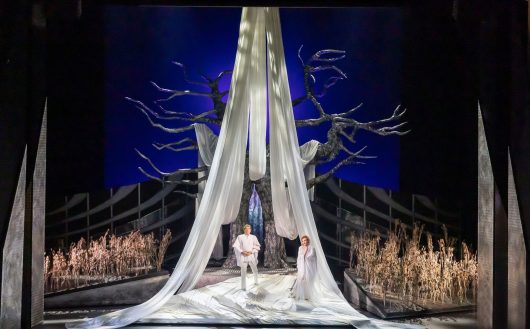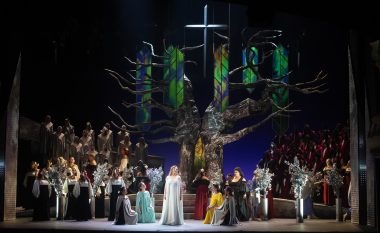Bulgaria’s first Lohengrin in forty years sensationally opens the 2024 Wagner Competition at Sofia Opera – Seen and Heard Worldwide
 Bulgaria Wagner, Lohengrin: Soloists, Males’s Refrain of Bulgarian Nationwide Radio, Refrain and Orchestra of Sofia Opera and Ballet / Constantin Trinks (conductor). Sofia Opera, 13.6.2024. (GT)
Bulgaria Wagner, Lohengrin: Soloists, Males’s Refrain of Bulgarian Nationwide Radio, Refrain and Orchestra of Sofia Opera and Ballet / Constantin Trinks (conductor). Sofia Opera, 13.6.2024. (GT)

Manufacturing:
Director – Plamen Kartaloff
Assistant Director – Yulia Krasteva
Set design – Hans Kudlich, Nela Stoyanova, Kristian Stoyanov
Vocal preparation – Anna Tomowa-Sintow
Costumes – Mario Cube
Visible director – Zach Blane
Laser results – Michael Zollinger
Refrain director of Sofia Opera – Violeta Dimitrova
Refrain director of Bulgarian Nationwide Radio Males’s Refrain – Lyubomira Alexandrova
Solid:
King Henry – Biser Georgiev
Lohengrin – Kostadin Andreev
Elsa von Brabant– Tsvetana Bandalovska
Duke Gottfried – Kalin Dushkov
Friedrich von Telramund – Ventseslav Anastasov
Ortrud – Gabriela Georgieva
Herald – Atanas Mladenov
4 Knights of Brabant – Angel Antonov, Rosen Nenchev, Nikolay Petrov, Nikolay Voynov
4 Pages – Radostina Obretenova, Yuliana Katinova, Gergana Petrova, Tsvetelina Kotseva
Plamen Kartaloff explains his conception of Richard Wagner’s Lohengrin as ‘an opera of sunshine and stylish religious purity. Its music is the embodiment of a spiritual thriller, a mystical union with the fantastic thing about the lifetime of its characters, passions of human weaknesses, impure forces, and the wrestle for energy, injustice and envy, however at odds with a world of outstanding priestly service to the perfect of justice, pure love, dedication and religious delight.’
In his staging of this work, the Bulgarian director means that ‘a couple of extra symbolic meanings give an emotional cost to the event of the motion. These are, within the first act, swan’s feathers falling from the sky, and after some time the swan’s wings descending, are the shock provoked by the miracle, which is commented upon with rapt consideration by all, and on this symbolism lies the looks of a better energy. It comes as a victory and salvation for the unjustly accused and the harmless heroine, Elsa. Later, after the marriage ritual, throughout the loving but distrustful and cautious union of marriage, within the final act, the snow-white marriage mattress is surrounded by a discipline of thorns – a logo of the envy and curse of Ortrud and Telramund, aiming on the destruction of the sunshine that illuminated the ability of affection and the happiness of Elsa and Lohengrin.’
Because the Prelude started, an progressive contact was to raise the curtain briefly displaying the ultimate scene from Parsifal of the monks at prayer, and Parsifal leaving as if getting ready us for Lohengrin. Constantin Trinks’s conducting was profoundly transferring within the nice flowing crescendo earlier than reworking right into a decrescendo embraced in brilliant tonal colors of A significant with really stunning taking part in by the orchestra. The opening scene of Act I introduced two raised ranges behind the Tree of Life with the gathered knights of Brabant current, reverse the Saxon and Thuringian counts. The King and Herald assume the centre earlier than the nice Tree of Life as their entry is introduced by the spectacular sonic fanfare of the 4 trumpeters on stage.
The King was properly portrayed by Biser Georgiev in his ‘Gott grüss euch, liebe Method von Brabant!’ and the Herald of Atanas Mladenov was additionally glorious. The magnificent baritone of Ventseslav Anastasov’s Friedrich in his ‘Dank, Konig, dir dass du zu richten kamst!’ led us to the story of Elsa’s obvious fratricide, his forgoing marrying her and as an alternative taking Ortrud as his spouse, and now he was demanding Elsa’s judgement. Elsa emerged from the Tree, in a shocking white robe, and her singing of ‘Einsam in trüben Tagen’ was matched by her characterisation, as if she has at all times been on this position.
The looks of Lohengrin was preceded by the descent of the swan’s wings upon the Tree of Life and his arrival above the tree. The sense of marvel at Lohengrin’s mysterious look was evident within the blended choruses singing ‘Was fasst uns selig süsses Grauen!’ and was much more efficient after Lohengrin’s declaring love for Elsa, the choruses singing, ‘Welch holde Wunder muss ich sehen?’ Within the problem from Friedrich, the choreography of the battle scene was temporary and dramatic and introduced slightly unsportingly to its climax by Lohengrin thrusting his sword into Telramund’s girth. Act I got here to a powerful shut by the 2 choruses, the principal singers and the very good orchestral taking part in on the peak of their powers, reminding one of many magnificent choral singing on this opera.

Act II opened with a fantastic crucifix above the Tree of Life, and windowed panels as if illuminating the minster, and within the background, figures could possibly be seen transferring within the church home windows. The offstage choral singing was magnificent in constructing a way of event. The opening scene was distinguished by excellent characterisation by the loveless sorceress Ortrud of Gabriela Georgieva, a powerful singer performing as if this position was made for her, and she or he was matched by one other singer new to me, Anastasov as Friedrich, whose singing was masterly in his characterisation of evil. Their dialogue ‘Du wilde Seherin!’ was intensely gripping, and even with out surtitles, one may perceive each nuance of their plotting to take down Lohengrin and Elsa. As Elsa sings ‘Euch Lüften, die mein Klagen…’ she is watched by Friedrich and Ortrud within the shadows, and the confrontation between Ortrud and Elsa turns into dramatically gripping as Ortrud tries to entice Elsa to assist restore them to the favour of the court docket.
The characterisation of excellent in opposition to the portrayal of nice evil was properly depicted within the scenes of Friedrich and Ortrud contrasted by Lohengrin and Elsa. Georgieva’s Ortrud, lurking within the background of Lohengrin and Elsa, consistently grimaced and introduced a unbroken menace. Each facial features was backed by magnificent singing. Anastasov’s Friedrich possesses a gravelly, darkish baritone voice and each ounce of malevolence was portrayed by this pair of evildoers. The shut of Act II was delivered to a dramatic conclusion by the pages bringing garlands of flowers surrounding the 2 lovers. And as Elsa moved ahead, the refrain sing ‘Heil dir, o Tugendreiche!’ The complete scene was terrific with magnificent orchestral taking part in. But Ortrud bursts ahead and calls for to know her lover’s id, whereas Friedrich accuses Lohengrin of magical powers. The scene is extremely dramatic, but ends, ‘Heil Elsa von Brabant!’
Constantin Trinks dealt with the Act III Prelude majestically evincing all the colorful harmonies of the Marriage ceremony March. Because the curtain opened, the bed room scene was marvellously represented by the 4 pages untwirling the white materials which had been slowly lifted above the Tree of Life to create a bed room scene the place the love scene between Lohengrin and Elsa unfolded, the ladies’s refrain singing, ‘Treulich bewacht bleibet zurück’. Within the nuptial scene, Tsvetana Bandalovska’s Elsa is supremely expressive as she sways between feelings of affection and curiosity at not figuring out Lohengrin’s identify.
The Lohengrin of Kostadin Andreev was finest on this intimate scene producing radiant singing, ‘Atmest du nicht mit mir die süssen Düfte?’ But Elsa’s suspicions emerge questioning if misfortune would come from figuring out his identify. She cries, ‘Den Namen sag mir an!’ and as Lohengrin sings, ‘Weh uns, was tatest du!’, Friedrich and his males seem with swords drawn. After Friedrich is slain, Elsa is left by Lohengrin to organize for the scene with the King.
The third scene earlier than the Tree of Life is filled with the blended choruses of troopers and knights but Lohengrin can not make them battle, singing ‘In fernem Land’. The shut of the opera was sensational with lightning putting and the splitting of the Tree of Life from which Gottfried appeared, and he slowly raised his arms to a robust end result. Kartaloff’s manufacturing created moments of magic within the superb visible occasions matched by Wagner’s wonderful rating, and the efficiency was blessed by very good characterisations by the main singers – most notably by Anastasov and by Georgieva as the 2 evil rivals to the crown, and the Elsa of Bandalovska – a singer of nice expertise and appearing. Her characterisation of the tragic position of Elsa was outstanding and a spotlight of this efficiency.
Of the principal singers, Lohengrin appeared underpowered in his singing, particularly in his greater notes, giving a considerably bleating sound, most noticeably in his ‘In fernem Land’. King Henry was just a little static in his portrayal however was in advantageous voice. Gottfried was good on the finish, with a putting persona.
Georgieva has an exquisite mezzo-soprano, which is vibrant and highly effective. For lengthy durations, she lurked within the background grimacing or making fearsome gestures in her rival’s route – she is a consummate actress, and one appears to be like ahead to listening to rather more from her. Her associate Anastasov has a outstanding baritone with a large vocal vary and is a consummate actor. I used to be shocked to be taught that this was his first main Wagner position; he and Georgieva’s Ortrud had been the vocal stars of the night past query.
I used to be very impressed by the mixed choral forces of the refrain of Sofia Opera and the lads’s refrain of Bulgarian Nationwide Radio. A number of of the massive scenes had been terrific, and the stirring route by Constantin Trinks held the entire present collectively magnificently. The costumes by Mario Cube had been conventional as they’d have been within the Center Ages, and the surroundings was superbly vibrant, usually dominated by the Tree of Life and the raised stands on both aspect, and the bed room scene was captivatingly stunning. The lighting and the visuals of Kartaloff’s staging had been excellent, and in all of the magnificent choral singing along with splendid orchestral taking part in and luxurious solo singers introduced the viewers to their ft on the shut – wholly justifying the staging of Lohengrin for the primary time in 4 a long time in Bulgaria. Kartaloff’s Wagner Competition is off to a terrific starting, and after the brand new Ring cycle, one other efficiency of Lohengrin with a second solid will shut the 2024 Competition in Sofia.
Gregor Tassie
